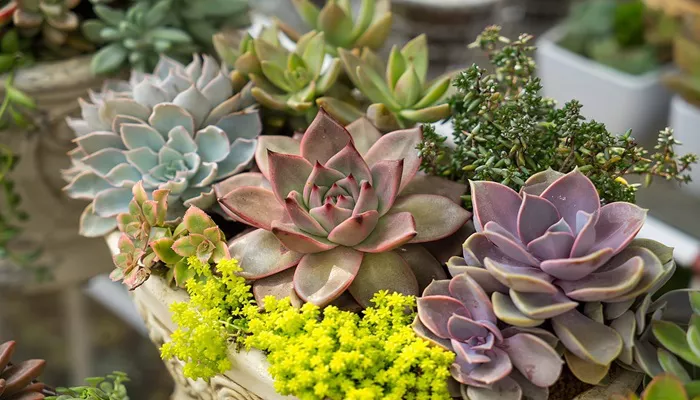Succulents are popular houseplants because they are low maintenance, visually appealing, and adaptable to various environments. One crucial aspect of keeping succulents healthy indoors is providing them with the right amount of light. Understanding their light needs will ensure your succulents thrive and remain vibrant.
Introduction to Succulent Light Requirements
Succulents are native to arid regions where they are accustomed to intense sunlight. Indoors, replicating these conditions can be challenging but is essential for their growth and health. Insufficient light can lead to weak, leggy plants, while too much direct sunlight can cause sunburn. Striking a balance is key.
Types of Light for Indoor Succulents
Natural Light
Natural light is the best source for indoor succulents. Placing them near windows ensures they receive the necessary light. However, not all windows provide the same quality and quantity of light.
- South-facing Windows: These windows offer the most intense light throughout the day. They are ideal for most succulents, ensuring they get enough light to stay healthy.
- East-facing Windows: These windows provide gentle morning sunlight, which is beneficial for succulents that need moderate light.
- West-facing Windows: These windows offer intense afternoon sunlight, which can be harsh but suitable for sun-loving succulents.
- North-facing Windows: These windows receive the least amount of light, often inadequate for most succulents.
Artificial Light
If natural light is insufficient, artificial light can supplement or replace it. Fluorescent lights and LED grow lights are excellent choices for providing the necessary spectrum and intensity of light.
- Fluorescent Lights: These are cost-effective and efficient. Use full-spectrum fluorescent bulbs to mimic natural sunlight.
- LED Grow Lights: These are more energy-efficient and can be customized to provide the exact light spectrum needed for succulents.
Determining the Right Amount of Light
Assessing Light Intensity
To determine if your succulents are getting the right amount of light, observe their appearance and growth patterns.
- Healthy Succulents: These have compact growth, vibrant colors, and firm leaves.
- Insufficient Light: Signs include stretched or leggy growth (etiolation), pale or faded colors, and weakened stems.
- Excess Light: Symptoms include scorched leaves, brown or white patches, and dried-out foliage.
Using Light Meters
Light meters are useful tools for measuring light intensity. They provide accurate readings of the light levels in different areas of your home, helping you choose the best spot for your succulents.
Monitoring and Adjusting Light Exposure
Regularly monitor your succulents and adjust their placement as needed. Rotate the pots occasionally to ensure even light distribution and prevent leaning towards the light source.
see also: Growing Moonstone Succulents: A Comprehensive Guide
Tips for Maximizing Light Exposure
Placing Near Windows
Position your succulents as close to windows as possible without touching the glass. This ensures they receive maximum light exposure.
Using Reflective Surfaces
Placing reflective surfaces, such as mirrors or white walls, near your succulents can help increase light intensity by reflecting light onto the plants.
Utilizing Sheer Curtains
Sheer curtains can diffuse intense sunlight, protecting succulents from sunburn while still providing adequate light.
Specific Light Needs for Common Indoor Succulents
Echeveria
Echeverias require bright, indirect light. They thrive near south or east-facing windows. Insufficient light can cause them to stretch and lose their rosette shape.
Aloe Vera
Aloe vera prefers bright, indirect sunlight. Place it near a south or west-facing window. Too much direct sunlight can cause the leaves to turn brown.
Jade Plant
Jade plants need bright light but can tolerate some direct sunlight. South or west-facing windows are ideal. Insufficient light causes them to become leggy.
Haworthia
Haworthias prefer bright, indirect light and can tolerate lower light levels. East or north-facing windows work well. Direct sunlight can scorch their leaves.
Zebra Plant
Zebra plants thrive in bright, indirect light. They do well in east or north-facing windows. Direct sunlight can cause their leaves to fade.
Seasonal Adjustments
Winter Light Needs
During winter, the intensity and duration of natural light decrease. Move your succulents closer to windows or use grow lights to compensate for the reduced light.
Summer Light Needs
In summer, the sunlight is more intense. Monitor your succulents for signs of sunburn and adjust their placement or use sheer curtains to diffuse the light.
Using Grow Lights Effectively
Choosing the Right Grow Light
Select grow lights that provide the full spectrum of light, including blue and red wavelengths. LED grow lights are efficient and customizable.
Setting Up Grow Lights
Position grow lights about 6-12 inches above the succulents. Ensure they receive 12-14 hours of light daily, simulating natural sunlight.
Timing and Duration
Use timers to automate the light schedule. Consistent light exposure is crucial for healthy growth.
Common Mistakes to Avoid
Overwatering Due to Insufficient Light
Succulents in low light require less water. Overwatering in low light conditions can lead to root rot.
Ignoring Signs of Light Stress
Pay attention to your succulents’ appearance. Promptly address signs of light stress by adjusting their placement or light exposure.
Neglecting Seasonal Changes
Adjust your succulents’ light exposure according to seasonal changes to prevent stress and promote healthy growth.
Conclusion
Providing the right amount of light is essential for the health and growth of indoor succulents. By understanding their light requirements and making necessary adjustments, you can enjoy vibrant, thriving succulents year-round. Remember to monitor their condition, use tools like light meters, and consider both natural and artificial light sources to meet their needs effectively.


